AMD Radeon HD 7770 GHz Edition and Radeon HD 7750 Graphics Cards Review

Let’s take a closer look at two reference graphics cards based on the junior AMD GPUs from the Southern Islands family – Cape Verde.
According to the Steam statistics, midrange or even entry-level graphics cards are the most popular among gamers. Apart from integrated graphics, we see such discrete solutions as Nvidia GeForce GTX 560/GTX 460 and AMD Radeon HD 5770 at the top of the list. AMD even holds that the Radeon HD 5770 is the absolute bestseller among DirectX 11 compatibles, enjoying as much as 28 percent of the market.
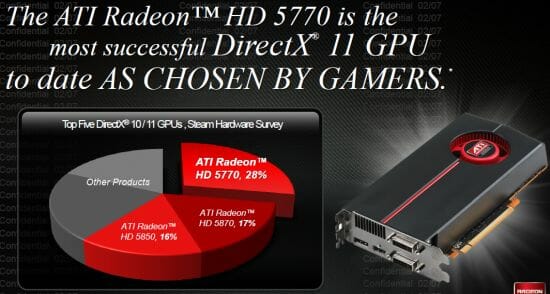
Although such marketing claims should be viewed with caution, we have to acknowledge that the HD 5770 and, later, HD 6770 is indeed a highly successful product thanks to its attractive price/performance ratio. That’s why AMD’s Tahiti GPU from the Southern Islands family was quickly followed by the Cape Verde and such graphics cards as Radeon HD 7770 GHz Edition and Radeon HD 7750. And it’s only then that they announced the Pitcairn. So today we are going to review and benchmark the junior products based on Southern Islands GPUs.
Architecture and Positioning
AMD seems to have got a complete line-up of Southern Islands GPUs and graphics cards now. The top market segment is occupied by the Tahiti and such cards as Radeon HD 7970 ($549) and HD 7950 ($449). The midrange products include the Pitcairn-based Radeon HD 7870 GHz Edition ($349) and HD 7850 ($249). The entry-level offers are the Radeon HD 7770 GHz Edition ($159) and HD 7750 ($109) based on the Cape Verde GPU.
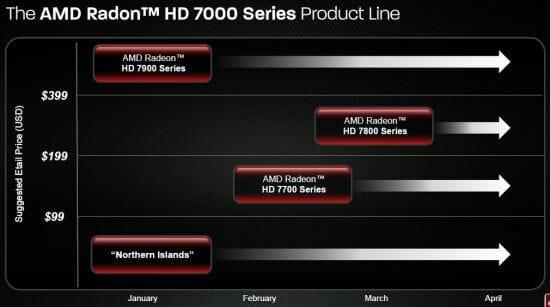
The bottom market segment is still populated by products with the previous-generation Northern Islands GPUs.
Talking about the Cape Verde, this 28nm GPU is the smallest in the new line-up at only 123 sq. mm. The next slide shows this clear enough.
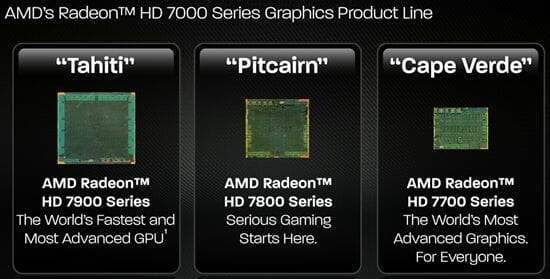
At the same time, its functionality is just the same as that of the Radeon HD 79xx series:
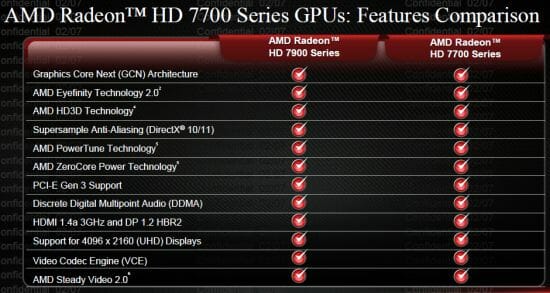
It’s based on the modern Graphics Core Next architecture, even though with significant simplifications due to the reduced manufacturing cost. For example, the senior variant, Cape Verde XT, has only 640 unified shader processors, 40 texture-mapping units and 16 raster operators, and its memory bus is only 128 bits wide:
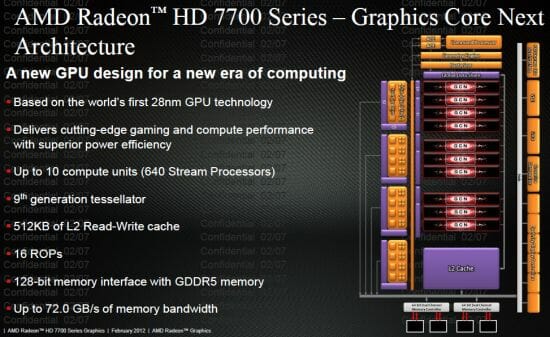
However, the new 28nm tech process permits to clock this GPU at a high frequency and endows it with high overclocking potential as is indicated by the next slide:
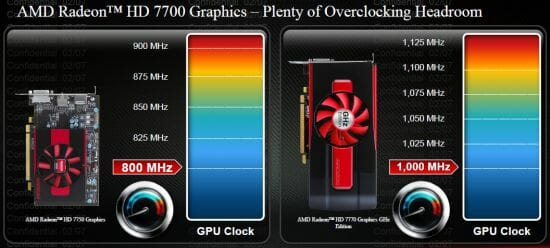
AMD also puts an emphasis on the energy efficiency of the new products. The Radeon HD 7770 GHz Edition has a typical power consumption of 80 watts while the junior Radeon HD 7750, only 55 watts. With the monitor turned off, these cards are expected to consume no more than 3 watts.
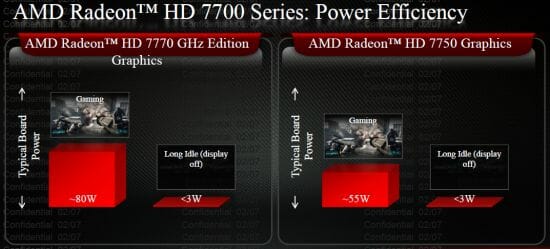
As for multi-GPU technologies, the next slide promises a twofold increase in performance in CrossFireX mode:
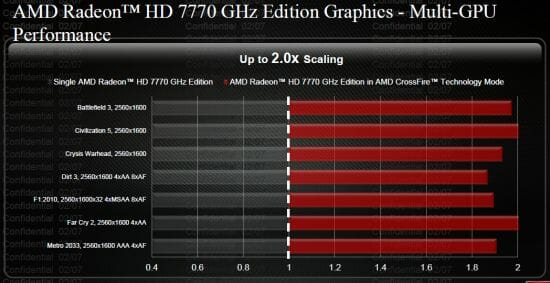
The 128-bit memory bus just won’t let the CrossFireX configuration be too fast, though.
The new cards’ specs are listed in the table below in comparison with AMD Radeon HD 7850, Radeon HD 6870, Radeon HD 6770 and GeForce GTX 560:
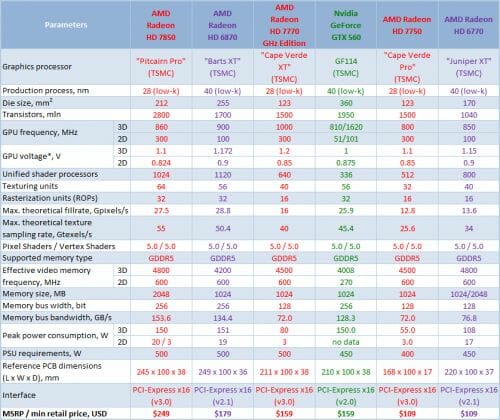
Closer Look at AMD Radeon HD 7770 GHz Edition and Radeon HD 7750
The pair of reference cards from AMD came to us without their official packaging and accessories. That’s often the case with reference samples although the Radeon HD 7770 and HD 7750 are both available in different versions from all the major brands by now. Our cards look like this.
They are very small, the HD 7770 being 211 millimeters long and the HD 7750, a mere 168 millimeters. The latter has a single-slot design even.
The Radeon HD 7770 GHz Edition is equipped with one dual-link DVI-I output, one HDMI connector and two mini-DisplayPorts. There’s a vent grid above them to exhaust the hot air out of the system case.
As for the Radeon HD 7750, it has one dual-link DVI-I, one HDMI and one DisplayPort. It has neither power nor MIO connectors which are available on the Radeon HD 7770 GHz Edition.
The HD 7770 GHz Edition employs a 3+1+1 power system with 3 phases for the GPU and 1 phase for the onboard memory. The Radeon HD 7750 is simpler in this respect, having only 2 phases for the GPU. The HD 7770 GHz supports software-based GPU voltage management whereas the HD 7750 lacks this feature.
The two 28nm Cape Verde chips have identical markings down to the date of manufacture (51’2011).
The clock rates comply with the official specs: 1000 MHz for the Radeon HD 7770 GHz Edition and 800 MHz for the HD 7750. The clock rate is lowered to 300 MHz in 2D mode. The rest of the specs are listed in the table above.Each card comes with 1 gigabyte of GDDR5 memory in four chips from Hynix Semiconductor.
Labeled H5GQ2H24MFR T2C, the chips have a rated clock rate of 5000 MHz, which leaves some room for overclocking since each card clocks its memory at 4500 MHz by default. The memory clock rate is reduced to 600 MHz in 2D applications. The memory bus is 128 bits wide.
Our GPUs turned out to have a rather low quality level: 72.7% for the Radeon HD 7770 GHz Edition and 74.3% for the Radeon HD 7750.
As for the cooling systems, the Radeon HD 7770 GHz Edition is equipped with an aluminum heatsink and a black fan under a plastic casing.The Radeon HD 7750 has a flat vapor chamber with a 60mm fan and some fins at the sides. It’s manufactured by NTK Limited.
Considering the low heat dissipation of both cards, these coolers seem to be quite sufficient for the task.
We run Aliens vs. Predator (2010) in five cycles at the highest settings (1920×1080, with 16x anisotropic filtering and without antialiasing) to check out the temperature of the tested cards. We used MSI Afterburner 2.2.0 Beta 15 and GPU-Z 0.6.0 as monitoring tools. This test was carried out with a closed system case at an ambient temperature of 25-26°C. We didn’t change the cards’ default thermal interface.
Unfortunately, our traditional method didn’t work with the Radeon HD 7750 because Aliens vs. Predator (2010) wouldn’t start on it for some reason. However, the card’s temperature was no higher than 62°C during other tests. As for the Radeon HD 7770 GHz Edition, here’s its temperature.
With its fan regulated automatically, the peak GPU temperature of the AMD Radeon HD 7770 GHz Edition was 72°C at a fan speed of 2010 RPM. When the fan was rotating at its maximum 4730 RPM, the temperature wasn’t higher than 64°C.
Then we measured the level of noise using an electronic noise-level meter CENTER-321 in a closed and quiet room about 20 sq. meters large. The noise-level meter was set on a tripod at a distance of 15 centimeters from the graphics card which was installed on an open testbed. The mainboard with the graphics card was placed at an edge of a desk on a foam-rubber tray.
The bottom limit of our noise-level meter is 29.8 dBA whereas the subjectively comfortable (not low, but comfortable) level of noise when measured from that distance is about 36 dBA. The speed of the graphics card’s fans was being adjusted by means of a controller that changed the supply voltage in steps of 0.5 V. We’ve included the results of a reference AMD Radeon HD 7850 into the next diagram.
The reference cooler of the Radeon HD 7770 GHz Edition turns out to be louder in the automatic mode than the far-from-quiet cooler of the reference Radeon HD 7850. Alas, reference cooling systems are generally noisy and only comfortable in 2D applications. As for the Radeon HD 7750, its cooler lacks a tachometer, so we can’t build its noise level graph. However, we could measure its peak noise at 12 volts: 58.8 dBA. Its minimum noise was 31.4 dBA at 3 volts.
The AMD Radeon HD 7750 behaved oddly during our overclockability test, too. Our testbed would hang up as soon as we tried to change the graphics card’s clock rates. Considering that other reviewers could overclock such cards to the level of the HD 7770 or even higher with the same software and drivers, we suspect it’s just a problem of our specific sample. So, we have to postpone this test until we get an off-the-shelf sample of that card.
As for the Radeon HD 7770 GHz Edition, we could overclock its GPU from 1000 to 1170 MHz (+17%) and its graphics memory from 4500 to 6280 MHz (+39.6%).
Further overclocking would require increasing the voltage of the GPU chip and this would call for a better cooler since the temperature of the overclocked Cape Verde XT was as high as 82°C.
Then we measured the power consumption of computer systems with different graphics cards using a multifunctional panel Zalman ZM-MFC3 which can report how much power a computer (the monitor not included) draws from a wall socket. There were two test modes: 2D (editing documents in Microsoft Word and web surfing) and 3D (the benchmark from Metro 2033: The Last Refuge at 1920×1080 with maximum settings).
The systems with the new cards from AMD indeed consume less power than the systems with the other graphics cards we’re going to benchmark today, although the difference isn’t large. A 450-watt power supply is going to be enough for every configuration, especially as our testbed is equipped with a well-overclocked six-core Intel Core i7-3960X Extreme Edition.
Testbed Configuration and Testing Methodology
All graphics cards were tested in a system with the following configuration:
- Mainboard: Intel Siler DX79SI (Intel X79 Express, LGA 2011, BIOS 0453 from 03/27/2012);
- CPU: Intel Core i7-3960X Extreme Edition, 3.3 GHz, 1.2 V, 6 x 256 KB L2, 15 MB L3 (Sandy Bridge-E, C1, 32 nm);
- CPU cooler: Phanteks PH-TC14PE (2 x 135 mm fans at 900 RPM);
- Thermal interface: ARCTIC MX-4;
- System memory: DDR3 4 x 4GB Mushkin Redline (Spec: 2133 MHz / 9-11-10-28 / 1.65 V);
- Graphics cards:
- AMD Radeon HD 7850 2 GB/256 bit GDDR5, 860/4800 MHz;
- Sapphire Radeon HD 6870 Dual Fan 1 GB/256 bit GDDR5, 900/4200 MHz;
- AMD Radeon HD 7770 1 GB/128 bit GDDR5, 1000/4500 MHz and 1170/6280 MHz;
- Gainward GeForce GTX 560 1 GB/256 bit GDDR5, 810/1620/4008 MHz;
- AMD Radeon HD 7750 1 GB/128 bit GDDR5, 800/4500 MHz;
- Asus Radeon HD 6770 DirectCU Silent (EAH6770 DC SL/2DI/1GD5) 1 GB/128 bit GDDR5, 850/4800 MHz;
- System drive: Crucial m4 256 GB SSD (SATA-III,CT256M4SSD2, BIOS v0009);
- Drive for programs and games: Western Digital VelociRaptor (300GB, SATA-II, 10000 RPM, 16MB cache, NCQ) inside Scythe Quiet Drive 3.5” HDD silencer and cooler;
- Backup drive: Samsung Ecogreen F4 HD204UI (SATA-II, 2 TB, 5400 RPM, 32 MB, NCQ);
- System case: Antec Twelve Hundred (front panel: three Noiseblocker NB-Multiframe S-Series MF12-S2 fans at 1020 RPM; back panel: two Noiseblocker NB-BlackSilentPRO PL-1 fans at 1020 RPM; top panel: standard 200 mm fan at 400 RPM);
- Control and monitoring panel: Zalman ZM-MFC3;
- Power supply: Xigmatek “No Rules Power” NRP-HC1501 1500 W (with a default 140 mm fan);
- Monitor: 30” Samsung 305T Plus.
Let me say a few words about the today’s competitors. We are going to compare the new graphics cards from AMD against the cards based on the previous generation GPUs – Radeon HD 6770 1GB from Asus and Radeon HD 6870 1 GB from Sapphire.
To estimate the performance difference between “Cape Verde” and “Pitcairn” we also included the reference AMD Radeon HD 7850 2 GB graphics accelerator. And as a direct competitor to AMD Radeon HD 7770 GHz Edition, we decided to go with GeForce GTX 560 1 GB from Gainward.
All graphics card frequencies were adjusted to match the nominal values.
In order to lower the dependence of the graphics cards performance on the overall platform speed, I overclocked our 32 nm six-core CPU with the multiplier set at 37x, BCLK frequency set at 125 MHz and “Load-Line Calibration” enabled to 4.625 GHz. The processor Vcore was increased to 1.45 V in the mainboard BIOS.
Hyper-Threading technology was enabled. 16 GB of system DDR3 memory worked at 2 GHz frequency with 9-11-10-28 timings and 1.65V voltage.
The test session started on April 9, 2012. All tests were performed in Microsoft Windows 7 Ultimate x64 SP1 with all critical updates as of that date and the following drivers:
- Intel Chipset Drivers 9.3.0.1020 WHQL from 01/26/2011 for the mainboard chipset;
- DirectX End-User Runtimes libraries from November 30, 2010;
- AMD Catalyst 12.3 driver from 03/28/2012 + Catalyst Application Profiles 12.3 (CAP1) from 03/29/2012 for AMD based graphics cards;
- Nvidia GeForce 301.24 beta from 04/09/2012 for Nvidia based graphics cards.
The graphics cards were tested in two resolutions: 1920×1080 and 2560×1600. The tests were performed in two image quality modes: “Quality+AF16x” – default texturing quality in the drivers with enabled 16x anisotropic filtering and “Quality+ AF16x+MSAA 4(8)x” with enabled 16x anisotropic filtering and full screen 4x anti-aliasing (MSAA) or 8x if the average framerate was high enough for comfortable gaming experience. We enabled anisotropic filtering and full-screen anti-aliasing from the game settings. If the corresponding options were missing, we changed these settings in the Control Panels of Catalyst and GeForce drivers. We also disabled Vsync there. There were no other changes in the driver settings.
The list of games and applications used in this test session includes two popular semi-synthetic benchmarking suites, one technical demo and 15 games of various genres:
- 3DMark Vantage (DirectX 10) – version 1.0.2.1, Performance and Extreme profiles (only basic tests);
- 3DMark 2011 (DirectX 11) – version 1.0.3.0, Performance and Extreme profiles;
- Unigine Heaven Demo (DirectX 11) – version 3.0, maximum graphics quality settings, tessellation at “normal”, AF16x, 1280×1024 resolution without MSAA and 1920×1080 with MSAA 4x;
- S.T.A.L.K.E.R.: Call of Pripyat (DirectX 11) – version 1.6.02, Enhanced Dynamic DX11 Lighting profile with all parameters manually set at their maximums, we used our custom cop03 demo on the Backwater map;
- Left 4 Dead 2 (DirectX 9) – version 2.1.0.0, maximum graphics quality settings, proprietary d98 demo (two runs) on “Death Toll” map of the “Church” level;
- Metro 2033: The Last Refuge (DirectX 10/11) – version 1.2, maximum graphics quality settings, official benchmark, “High” image quality settings; tesselation, DOF enabled; AAA aliasing enabled, two consecutive runs of the “Frontline” scene;
- Just Cause 2 (DirectX 11) – version 1.0.0.2, maximum quality settings, Background Blur and GPU Water Simulation disabled, two consecutive runs of the “Dark Tower” demo;
- Aliens vs. Predator (2010) (DirectX 11) – Texture Quality at “High”, Shadow Quality at “High”, SSAO enabled, two test runs in each resolution;
- Lost Planet 2 (DirectX 11) – version 1.0, maximum graphics quality settings, motion blur enabled, performance test “B”;
- StarCraft 2: Wings of Liberty (DirectX 9) – version 1.4.3, all image quality settings at “Extreme”, Physics at “Ultra”, reflections On, two 2-minute runs of our own “bench2” demo;
- Sid Meier’s Civilization V (DirectX 11) – version 1.0.1.348, maximum graphics quality settings, two runs of the “diplomatic” benchmark including five heaviest scenes;
- Tom Clancy’s H.A.W.X. 2 (DirectX 11) – version 1.04, maximum graphics quality settings, shadows On, tessellation Off (not available on Radeon), two runs of the test scene;
- Total War: Shogun 2 (DirectX 11) – version 2.0, built in benchmark (Sekigahara battle) at high graphics quality settings and with MSAA 4x in one of the test modes;
- Crysis 2 (DirectX 11) – version 1.9, we used Adrenaline Crysis 2 Benchmark Tool v.1.0.1.13. BETA with “Very High” graphics quality profile and activated HD textures, two runs of a demo recorded on “Times Square” level;
- DiRT 3 (DirectX 11) – version 1.2, built-in benchmark at maximum graphics quality settings on the “Aspen” track;
- Hard Reset Demo (DirectX 9) – benchmark built into the demo version with Ultra image quality settings, one test run;
- Batman: Arkham City (DirectX 11) – version 1.2, maximum graphics quality settings, physics disabled, two sequential runs of the benchmark built into the game.
- Battlefield 3 (DirectX 11) – version 1.3, all image quality settings set to “Ultra”, two successive runs of a scripted scene from the beginning of the “Going Hunting” mission 110 seconds long.
If the game allowed recording the minimal fps readings, they were also added to the charts. We ran each game test or benchmark twice and took the best result for the diagrams, but only if the difference between them didn’t exceed 1%. If it did exceed 1%, we ran the tests at least one more time to achieve repeatability of results.
Performance
The graphics cards are listed in the diagrams in the order of descending retail price:
- Radeon HD 7850 2 GB – starting at $249;
- Radeon HD 6870 1 GB – starting at $179;
- Radeon HD 7770 1 GB – starting at $159;
- GeForce GTX 560 1 GB – starting at $159;
- Radeon HD 7750 1 GB – starting at $109;
- Radeon HD 6770 1 GB – starting at $109.
3DMark Vantage
The Cape Verde based cards are far from impressive in our first semi-synthetic benchmark. The Radeon HD 7750 is hardly any faster than the HD 6770 which costs the same money whereas the Radeon HD 7770 GHz Edition is routed by the GeForce GTX 560 which can be bought for the same recommended $159. Overclocking doesn’t help: the 128-bit bus prevents the high-frequency Radeon HD 7770 from beating the Radeon HD 6870.
3DMark 2011
The overall picture is the same as in the previous version of 3DMark.
Unigine Heaven Demo
The new cards from AMD look more confident in this tech demo.
They are ahead of the previous-generation Radeon HD 6770 and (with the help of overclocking) of the HD 6870. The Radeon HD 7770 GHz Edition can’t beat the GeForce GTX 560 even when overclocked, though.
S.T.A.L.K.E.R.: Call of Pripyat
The first game on our list doesn’t contradict 3DMark except that the overclocked Radeon HD 7770 can beat the GeForce GTX 560.
Left 4 Dead 2
This game produces a different picture.
The Radeon HD 7770 GHz Edition falls far behind the GeForce GTX 560 whereas the HD 7750 can’t beat the HD 6770.
Metro 2033: The Last Refuge
Although we don’t use the maximum visual quality settings here, the new cards are awfully slow in Metro 2033: The Last Refuge. There’s nothing new in terms of how the new AMD cards compare with their opponents.
Just Cause 2
The next two games produce the same standings.
Lost Planet 2
As opposed to the two previous games, the overclocked Radeon HD 7770 GHz Edition overtakes the standard Radeon HD 6870 in Lost Planet 2. That’s hardly a consolation for the newcomer considering that it gets beaten by its main opponent GeForce GTX 560.
StarCraft II: Wings of Liberty
The Radeon HD 7750 can’t cope with the HD 6770 while the Radeon HD 7770 GHz Edition is just as hopeless as its junior cousin. The same goes for the next eight games.
Performance Summary
First, let’s see the difference between the AMD Radeon HD 7770 GHz Edition and the Radeon HD 7750 at their default clock rates, the junior card being the baseline.
The HD 7770 GHz Edition is an average 28% and 27% faster than the HD 7750 with antialiasing off and on, respectively. This difference can hardly justify the 50% higher price of the HD 7770 GHz Edition. AMD seems to realize that, too. The recommended price of that card is expected to be reduced from $159 to $139 in the near future but we still think it’s too high for such a low performance.
Now let’s compare the AMD Radeon HD 7770 GHz Edition with the Radeon HD 6770.The gap is 33-35% on average across all the tests. It’s the largest in the tessellation-heavy Unigine Heaven and Lost Planet 2 and smallest in Aliens vs. Predator (2010), DiRT 3, Left 4 Dead 2 and Metro 2033: The Last Refuge.
The next chart shows that the Radeon HD 7850 is much faster than the AMD Radeon HD 7770 GHz Edition.
We can remind you that the price difference between the HD 7770 ($159) and HD 7850 ($249) is $90 or 57%, so there’s a rather large unoccupied niche in the popular price range. Perhaps AMD will roll out something like a Radeon HD 7830 for $179-189 or even cut the price of the Radeon HD 7850 to that level!
Now the final chart compares the AMD Radeon HD 7770 GHz Edition with the Nvidia GeForce GTX 560.The HD 7770 is routed by its opponent. The GeForce GTX 560 is an average 20% and 24% faster with antialiasing off and on, respectively. And these two cards come at almost the same recommended prices!
Conclusion
The AMD Radeon HD 7770 GHz Edition and Radeon HD 7750 graphics cards have come to replace the Radeon HD 6770 and HD 6750 and are indeed faster, yet not fast enough to compete with Nvidia’s previous-generation solutions, particularly the GeForce GTX 560. In fact, the Radeon HD 7750 ($109) can’t be viewed as an entry-level gaming card since its performance is too low even for 1920×1080, which is the lowest standard resolution for a gaming computer. The Radeon HD 7770 GHz Edition is somewhat more interesting but seems to be overpriced at its $159, so we expect it to get as cheap as $139 and thus avoid the comparison with the GeForce GTX 560 which is obviously faster. Instead, it should compete against the GeForce GTX 560 SE or even the GTX 550 Ti.
t is a shame that despite the low memory prices and the new GPU tech process AMD still equips its junior graphics cards with a 128-bit memory bus which cannot be compensated by the high clock rate. You can take a look at the results of the Radeon HD 6870 or GeForce GTX 560 with their 256-bit bus to understand the problem.
Another problem is the large performance and price gap between the Radeon HD 7770 GHz Edition and Radeon HD 7850. AMD should fill it in quickly before Nvidia does the same.
That said, we still want to praise the new AMD cards for their good energy efficiency, compact design and support for all popular interfaces and technologies. You may want to choose one of them for a modest gaming computer.